Mixi Bundle
How Did Mixi Company Evolve?
Embark on a journey through the Mixi SWOT Analysis to understand its strategic moves. From its humble beginnings in 1999 as E-Mercury, Inc., to its current status as a diversified entertainment giant, the Mixi company has undergone a remarkable transformation. This Mixi history reveals the strategic pivots and innovations that have defined its path.
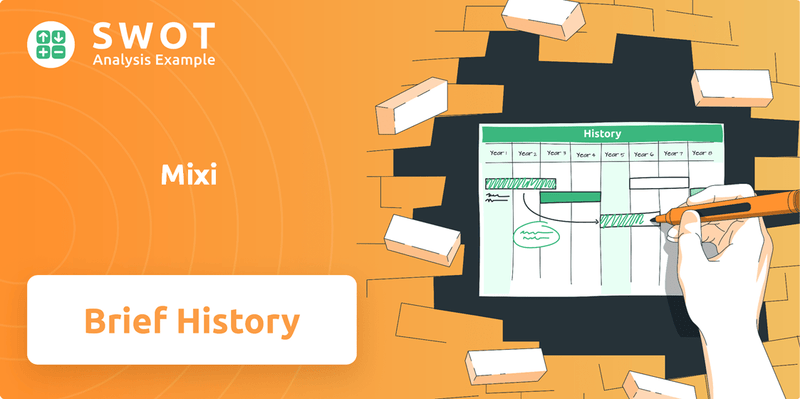
The Mixi timeline showcases a fascinating evolution, from its early focus on Japanese social media and social networking Japan to its expansion into mobile gaming. Understanding Mixi's platform and its strategic decisions provides valuable insights for investors and business strategists alike. Explore the brief history of Mixi Japan to uncover how it navigated the competitive landscape.
What is the Mixi Founding Story?
The Mixi company, a significant player in the Japanese social media landscape, has a compelling founding story. It began in 1999, the brainchild of Kenji Kasahara, who initially established the company as a limited liability entity. The company's evolution reflects the dynamic nature of the internet and social networking.
The company's journey started with the name E-Mercury, Inc. However, in February 2006, the company rebranded to Mixi, Inc., to better align with its flagship social networking service, 'mixi'. This shift underscored the company's commitment to its core product and its vision for fostering online communities. The headquarters are located in Shibuya, Tokyo.
Kenji Kasahara saw an opportunity to build a platform that would encourage personal connections and community building. The initial focus was on enabling deeper, more meaningful communication among users. The Mixi platform, launched in February 2004, allowed users to connect with friends, exchange messages, keep diaries, and participate in online communities. While specific details about initial funding are not widely publicized, the company's early growth suggests a successful bootstrapping or seed funding phase, leading to its IPO in September 2006. The cultural context of Japan, with its emphasis on close-knit communities and the growing adoption of internet services, provided a favorable environment for Mixi's social networking venture.
Here's a look at some key moments in the Mixi history:
- 1999: Kenji Kasahara founds the company, initially named E-Mercury, Inc.
- 2000: The company is incorporated as a Japanese corporation.
- February 2004: The Mixi platform, the social networking service, is launched.
- February 2006: The company changes its name to Mixi, Inc.
- September 2006: Mixi goes public with its IPO.
The early years of Mixi saw the company establish itself as a key player in the Japanese social media scene. The platform's user base grew, and it became a significant part of Japanese culture. For more details on the business model, check out this article: Revenue Streams & Business Model of Mixi.
Mixi SWOT Analysis
- Complete SWOT Breakdown
- Fully Customizable
- Editable in Excel & Word
- Professional Formatting
- Investor-Ready Format
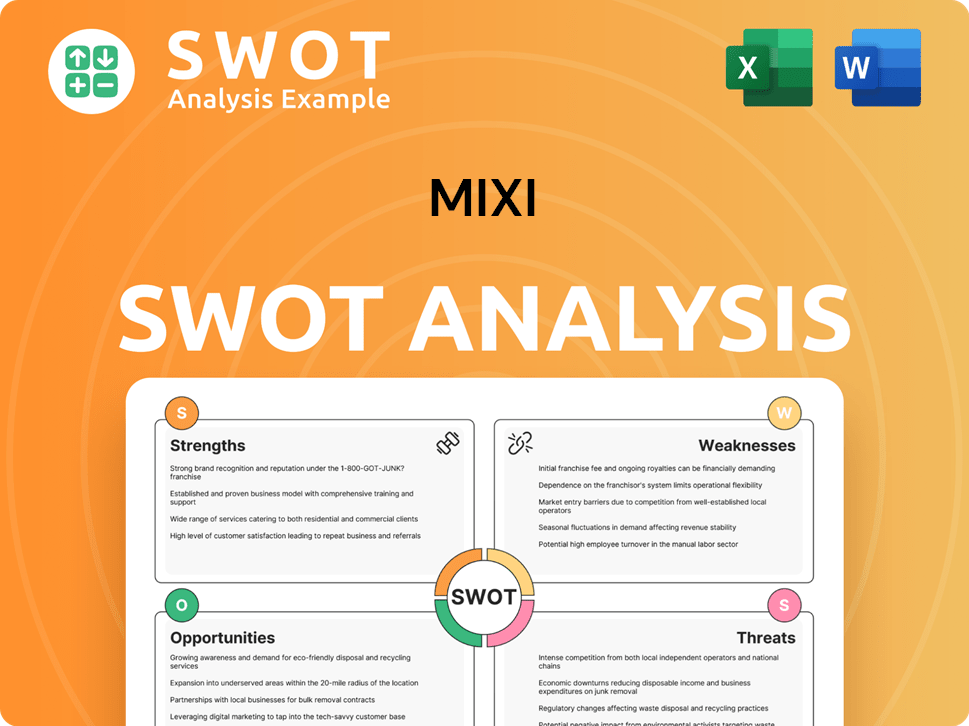
What Drove the Early Growth of Mixi?
The Mixi company, a prominent player in the Japanese social media landscape, experienced rapid growth following its February 2004 launch. This early success established the Mixi platform as a significant online hub. The company's strategic moves, particularly its foray into mobile gaming, fueled further expansion.
By September 2012, the
The launch of 'Monster Strike' in September 2013 marked a pivotal moment. This mobile freemium game quickly became a phenomenon, surpassing $1 billion in revenue by 2015. 'Monster Strike' maintained ten-figure player spending for four consecutive years, peaking at $1.7 billion in 2016, solidifying digital entertainment as a major revenue driver for the Mixi company.
Beyond gaming, Mixi expanded into lifestyle services. This included 'FamilyAlbum,' a photo and video sharing app for families launched in 2015. By November 2023, FamilyAlbum had reached over 20 million users globally, with approximately 40% of its user base being international, showcasing Mixi's corporate history of diversification.
In the fiscal year ending March 31, 2025, Mixi's net sales reached ¥154,847 million, a 5.4% increase from the previous year. The sports business saw a 22.1% increase in net sales, with segment profit reaching ¥1,999 million. The investment business experienced a 286.9% increase in net sales, reflecting the
Mixi PESTLE Analysis
- Covers All 6 PESTLE Categories
- No Research Needed – Save Hours of Work
- Built by Experts, Trusted by Consultants
- Instant Download, Ready to Use
- 100% Editable, Fully Customizable
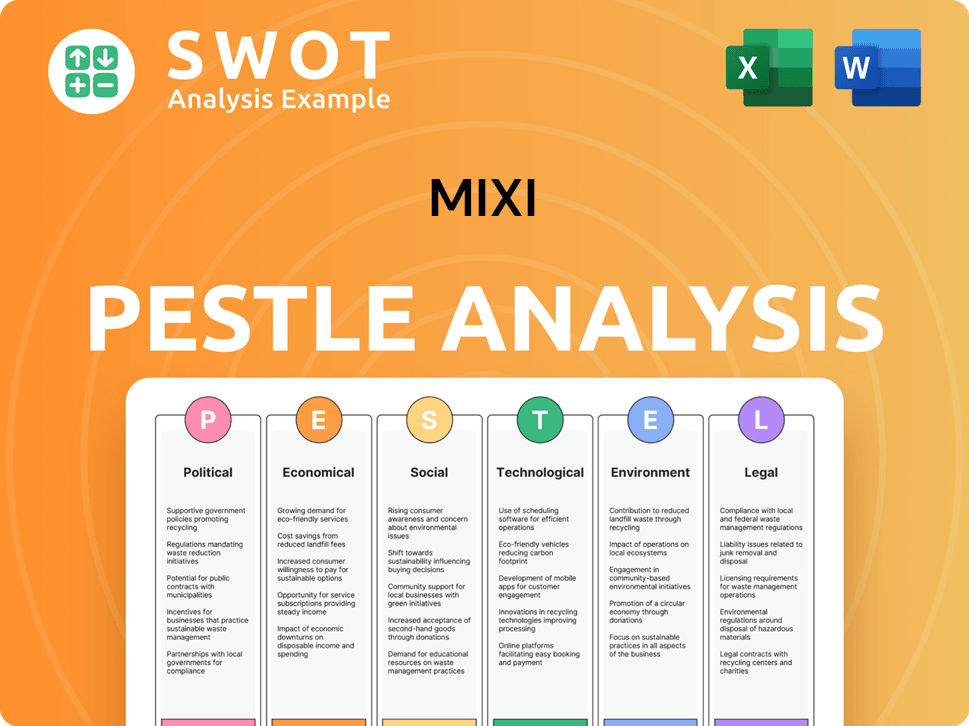
What are the key Milestones in Mixi history?
The Mixi company has a rich Mixi history, marked by significant achievements and strategic shifts. The Mixi timeline reveals a company that has evolved from a social networking pioneer to a diversified entertainment and lifestyle business.
| Year | Milestone |
|---|---|
| 2004 | Launched 'mixi', establishing itself as a key player in Japanese social media. |
| 2013 | Released 'Monster Strike', a mobile game that became a global phenomenon. |
| 2016 | Acquired a professional sports team, expanding into the sports business. |
| 2024 | Maintained high monthly active users for 'Monster Strike' through 10th-anniversary activities and IP collaborations. |
Innovation at the company has been pivotal, particularly with the introduction of 'Monster Strike'. This mobile game was a groundbreaking success, generating substantial revenue and enabling the company to diversify its business model beyond its initial Social networking Japan focus.
The launch of the Mixi platform in 2004 marked the company's entry into the social networking space. This early move established the company as a pioneer in Japanese social media.
The release of 'Monster Strike' in 2013 was a major innovation, transforming the company into a significant player in the mobile gaming industry. The game's success allowed for business diversification.
The acquisition of a professional sports team demonstrated the company's strategic diversification into the sports and lifestyle sectors. This move aimed to balance revenue streams and expand market presence.
Despite its successes, the company has faced challenges, including market saturation in the domestic gaming sector. The company has strategically diversified into sports and lifestyle businesses to balance its revenue streams, while also adapting to changing market dynamics.
The maturation of the domestic gaming market has limited growth and future earnings visibility for the digital entertainment segment. This has led to strategic shifts in business focus.
Increased competition in both the social networking and gaming sectors has put pressure on the company. This has required continuous innovation and strategic adaptation to maintain market share.
Challenges in the lifestyle segment, particularly with revenue not meeting expectations, have prompted a focus on enhancing monetization strategies. This includes platforms like FamilyAlbum.
Exiting several game titles to improve operating profit reflects the company's ability to adapt to market conditions. This strategic move aims to streamline operations and focus on profitable ventures.
Mixi Business Model Canvas
- Complete 9-Block Business Model Canvas
- Effortlessly Communicate Your Business Strategy
- Investor-Ready BMC Format
- 100% Editable and Customizable
- Clear and Structured Layout
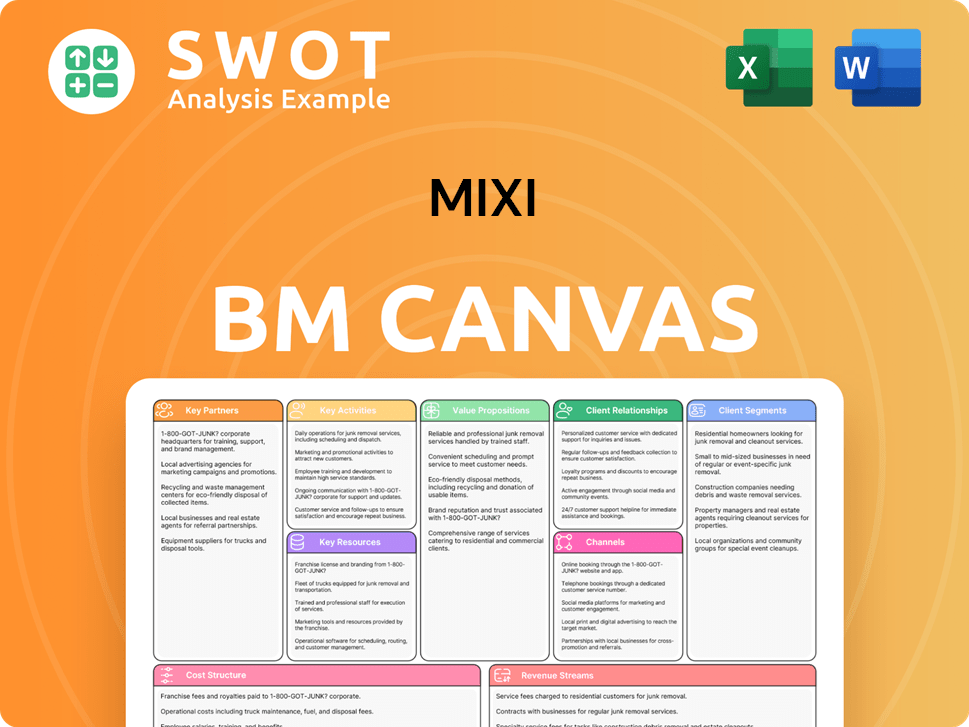
What is the Timeline of Key Events for Mixi?
The Mixi company has a rich Mixi history, marked by significant developments since its inception. From its early days as E-Mercury, Inc., to its evolution into a leading Japanese social media platform, the company has consistently adapted and innovated. The Mixi timeline showcases its strategic moves, including the launch of its social networking service, the introduction of the hugely successful mobile game 'Monster Strike', and its expansion into family-oriented services.
| Year | Key Event |
|---|---|
| 1999 | Kenji Kasahara founded E-Mercury, Inc., the precursor to Mixi, Inc. |
| 2000 | E-Mercury, Inc. became a Japanese corporation. |
| 2004 | The social networking service 'mixi' was launched. |
| 2006 | The company changed its name to Mixi, Inc. and went public via IPO. |
| 2013 | 'Monster Strike,' a highly successful mobile game, was launched. |
| 2015 | 'FamilyAlbum,' a family photo-sharing app, was released, and 'Monster Strike' surpassed $1 billion in revenue. |
| 2017 | Mixi signed a partnership agreement with CHIBA JETS FUNABASHI, a professional basketball team. |
| 2019 | CHIBA JETS became a Mixi group company. |
| 2022 | The company name was updated to MIXI, Inc. |
| November 2023 | FamilyAlbum surpassed 20 million users globally. |
| April 2024 | LaLa arena TOKYO-BAY, a multipurpose arena partly developed by Mixi for the CHIBA JETS, was completed. |
| December 31, 2024 | Mixi reported net sales of ¥110,352 million for the nine months, a 4.9% increase year-over-year. |
| March 31, 2025 | Mixi's annual revenue reached ¥154,847 million, a 5.4% increase from the previous year, with profit attributable to owners of the parent surging by 148.5%. |
For fiscal year 2025 (April 2024 - March 2025), the company projects net sales of 147 billion yen. EBITDA is estimated at 23 billion yen, operating income at 18.5 billion yen, and profit attributable to owners of the parent at 12 billion yen. These projections reflect Mixi's strategic focus on sustainable growth across its diverse business segments.
Mixi plans to maximize revenue through business growth and expansion via M&A. They are also focused on optimizing shareholders' equity. The company intends to strengthen globalization initiatives across its business segments, including releasing a localized 'Monster Strike' title for the Indian market and expanding sports betting services in Australia.
The company aims to enhance monetization strategies for its lifestyle services, such as FamilyAlbum, by expanding product lineups. They are also investing in overseas user acquisition, particularly in regions with higher birthrates. This strategy is designed to increase the user base and revenue streams.
Mixi remains optimistic about leveraging its expertise in communication services and cutting-edge technologies like AI. The goal is to build a sustainable earnings base, aligning with its founding vision of enriching communication and inspiring moments of joy. This approach is key to maintaining its competitive edge.
Mixi Porter's Five Forces Analysis
- Covers All 5 Competitive Forces in Detail
- Structured for Consultants, Students, and Founders
- 100% Editable in Microsoft Word & Excel
- Instant Digital Download – Use Immediately
- Compatible with Mac & PC – Fully Unlocked
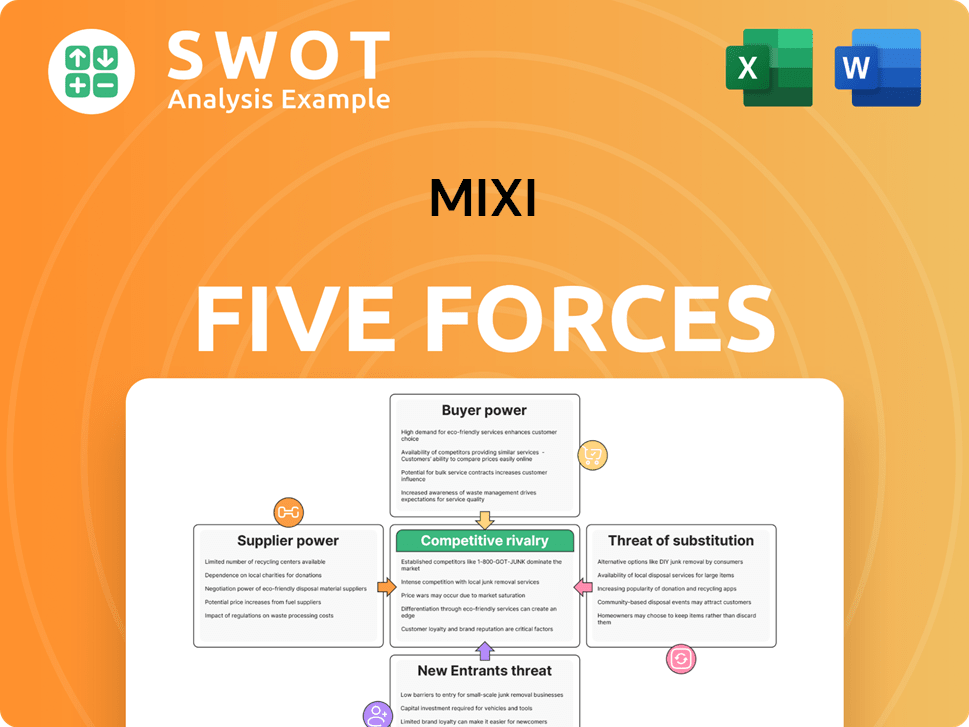
Related Blogs
- What is Competitive Landscape of Mixi Company?
- What is Growth Strategy and Future Prospects of Mixi Company?
- How Does Mixi Company Work?
- What is Sales and Marketing Strategy of Mixi Company?
- What is Brief History of Mixi Company?
- Who Owns Mixi Company?
- What is Customer Demographics and Target Market of Mixi Company?
Disclaimer
All information, articles, and product details provided on this website are for general informational and educational purposes only. We do not claim any ownership over, nor do we intend to infringe upon, any trademarks, copyrights, logos, brand names, or other intellectual property mentioned or depicted on this site. Such intellectual property remains the property of its respective owners, and any references here are made solely for identification or informational purposes, without implying any affiliation, endorsement, or partnership.
We make no representations or warranties, express or implied, regarding the accuracy, completeness, or suitability of any content or products presented. Nothing on this website should be construed as legal, tax, investment, financial, medical, or other professional advice. In addition, no part of this site—including articles or product references—constitutes a solicitation, recommendation, endorsement, advertisement, or offer to buy or sell any securities, franchises, or other financial instruments, particularly in jurisdictions where such activity would be unlawful.
All content is of a general nature and may not address the specific circumstances of any individual or entity. It is not a substitute for professional advice or services. Any actions you take based on the information provided here are strictly at your own risk. You accept full responsibility for any decisions or outcomes arising from your use of this website and agree to release us from any liability in connection with your use of, or reliance upon, the content or products found herein.